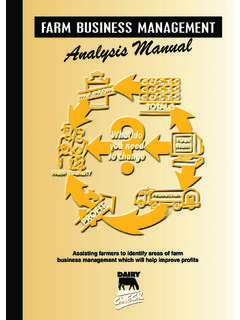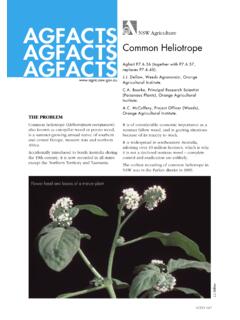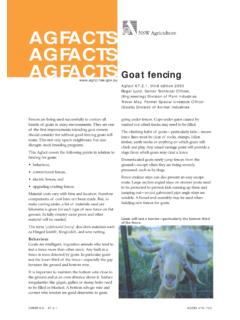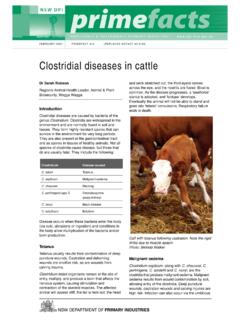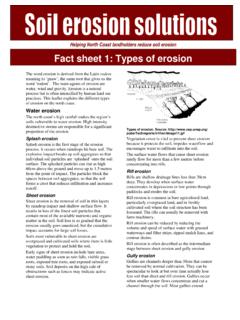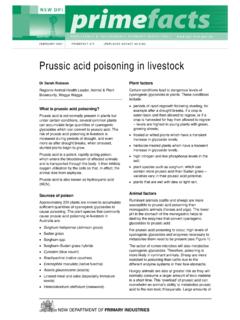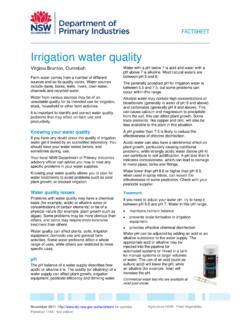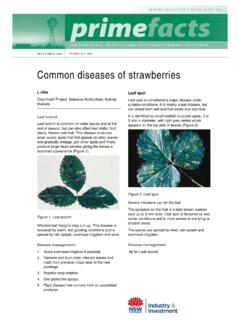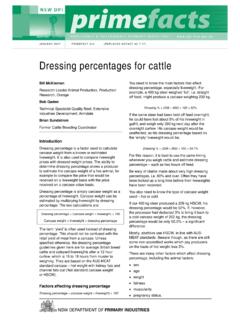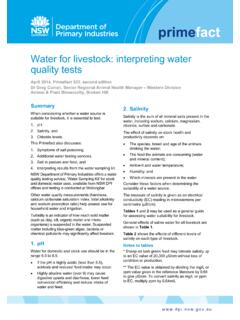Transcription of Passionfruit growing: what you need to know
1 Year high prices for Passionfruit over theOctober - November period attract the attentionof potential many only see the high pricesover a short period and fail to understand someof the pitfalls in growing the crop and thedifficulty of producing fruit at this time of production on the north coast ofNSW has a long history of ups and downs dueto oversupply, depressed market prices, and viraland fungal disease , a number of important pointsneed considering when making a decision to need: frost-free land facing north to east that issheltered from the wind; a water supply and irrigation system to irrigatethe crop over a 5 to 6 month period; a good understanding of the diseases and pestswhich attack and defoliate vines; the correct equipment to spray the vines apower or boom spray is satisfactory in youngvines, however an airblast sprayer is requiredwhen vines thicken up; a commitment to maintain the vines.
2 Withoutregular spraying, irrigation and fertilising theproduction and quality of fruit is substantiallyreduced; a supply of labour to maintain vines and toharvest and pack growing is best suited to the far northcoast of NSW because the varieties bred at theCentre for Tropical Horticulture over the last 15years are hybrids between the tropicalpassionfruit (Passifora edulis forma flavicarpa) andthe common Passionfruit (Passiflora edulis). Thesehybrids are suited to subtropical conditions butare cold sensitive and susceptible to should only be made in sheltered, frost-free sites on the far north coast. growing thesevines in other locations may result in lowerperformance and areas may be suited to the commonblack Passionfruit but hybrid Passionfruit shouldnot be planted in the cooler REQUIREMENTSP assionfruit growing is well suited to familyoperated farms. Many Passionfruit growers haveother fruit crops or agricultural growing involves intensive use oflabour throughout the year.
3 Labour is needed fordisease and pest control, fertilising, harvestingand packing over a 10-month period. Passionfruitvines bear over an extended period carryingsummer, autumn and winter crops. During thesummer, fruit has to be picked up early in themorning every day to avoid losses from sunburnand fruit technology has recently been developedto mechanically harvest Passionfruit from theground. Plantations should be designed formechanical harvesting in regard to row spacing,degree of slope and headlands for turning. Rockysoils are commence cropping at 6 months of ageand reach full bearing in 18 months. Vines havea productive life of 3 to 4 years. New plantingsshould be made on a continuous 3 year rotationto maintain growing :what you need toknowAgnote 1/082, 3rd edition Dirou, District HorticulturistNSW Centre for Tropical Horticulture, Alstonville2 Well managed vines can produce 20 to 30 kg,or 2 to 3 cartons, per vine each year.
4 Not all fruitis of fresh market standard. budget on 70% freshfruit and 30% COSTSE xcluding the cost of land, fencing, damconstruction and pump, the vine establishmentcost per hectare can amount to $15 000. The maincosts are trellising $6000, irrigation $4000, vinepurchase, planting and training $ COSTSThe gross income for one years production basedon 15 tonnes per hectare, with 70% fresh marketfruit at $ and 30% processing fruit at 53cents/kg would be $23 400, with annual variablecosts totalling $17 500. Owner labour is costedfor all operations. Some overhead costs, , electricity and depreciation are AND PESTSP assionfruit growing involves extensive use offungicides and some insecticides. A number ofleaf fungal diseases can infect vines at most timesof the year. For this reason a regular sprayingprogram is needed. Up to 20 fungicide sprays canbe applied in a year. Insect pests such asQueensland fruit fly, red scale, fruit spotting bug, Passionfruit mite and mealy bug can all causemajor problems resulting in leaf and stem damageand fruit rejection if not growing should not be attempted onthe north coast without an adequate supply ofirrigation water.
5 Irrigation is needed over thespring and summer periods when the vines aremaking lush vegetative growth and are carrying aheavy irrigation based on a monitoringsystem for example soil tensiometers, is bestapplied using undervine microjets or can require up to 400 L per vine per weekfrom August to January depending on weatherconditions, soil type and depth. To supply thisamount of water you need a farm dam with acapacity of 2 to 3 megalitres per hectare of you are considering growing Passionfruit onyour property ensure that: you have the correct type of land a frost freearea, an aspect facing east to north that can besheltered from winds; you have an adequate water supply to irrigatethe crop each year; you are prepared to spray regularly to controldisease; and you are prepared to work the crop full INFORMATIONFor further information contact the author or yourdistrict horticulturist.
6 The State of New South WalesNSW Department of Primary IndustriesEdited by Bill NoadCommunications BranchDubbo, September 2004 Agdex 238/10 Job No. 5005 DISCLAIMERThe information contained in this publication is based onknowledge and understanding at the time of writing(August 2004). However, because of advances inknowledge, users are reminded of the need to ensurethat information upon which they rely is up to date and tocheck currency of the information with the appropriateofficer of the New South Wales Agriculture or he user sindependent READ THE LABELU sers of agricultural (or veterinary) chemical productsmust always read the label and any Permit, before usingthe product, and strictly comply with the directions on thelabel and the conditions of any Permit. Users are notabsolved from compliance with the directions on the labelor the conditions of the permit by reason of any statementmade or omitted to be made in this publication.
